The GIGABYTE Server MW31-SP0 Motherboard Review: A Quick Look at C236
by Ian Cutress on April 21, 2016 10:00 AM EST- Posted in
- Motherboards
- Gigabyte
- Xeon
- Enterprise
- C236
Despite the fact that the MW31-SP0 is not necessarily a gaming-focused system, the use of a PLX switch suggests that GPU intercommunication is going to be a big part of the appeal to this motherboard. This can either be through gaming or compute tasks using PCIe co-processors, or if the system is paired with a few network cards to act as a switch/router or firewall when required. As a way of testing the PCIe slots, we put the board through our regular GPU tests.
Gaming Performance 2015
Our 2015 gaming results are still relatively new, but the issue of FCLK settings might play a big role here. At launch, the default setting for the communication buffer between the CPU and PCIe stack was 800 MHz, even though Intel suggested 1000 MHz, but this was because of firmware limitations from Intel. Since then, there is firmware to enable 1000 MHz, and most motherboard manufacturers have this - but it is unclear if the motherboard will default to 1000 MHz and it might vary from BIOS version to BIOS version. As we test at default settings, our numbers are only ever snapshots in time, but it leads to some interesting differences in discrete GPU performance.
Alien: Isolation
If first person survival mixed with horror is your sort of thing, then Alien: Isolation, based off of the Alien franchise, should be an interesting title. Developed by The Creative Assembly and released in October 2014, Alien: Isolation has won numerous awards from Game Of The Year to several top 10s/25s and Best Horror titles, ratcheting up over a million sales by February 2015. Alien: Isolation uses a custom built engine which includes dynamic sound effects and should be fully multi-core enabled.
For low-end graphics, we test at 720p with Ultra settings, whereas for mid and high range graphics we bump this up to 1080p, taking the average frame rate as our marker with a scripted version of the built-in benchmark.
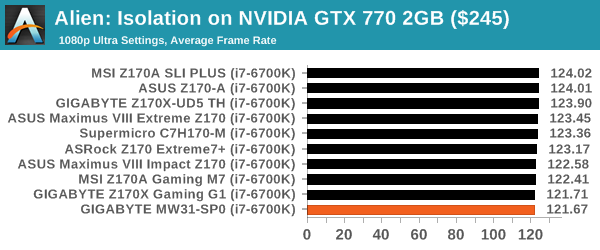
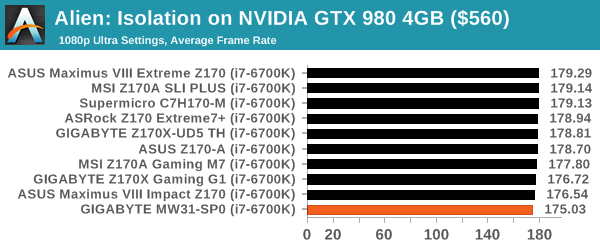
Total War: Attila
The Total War franchise moves on to Attila, another The Creative Assembly development, and is a stand-alone strategy title set in 395AD where the main storyline lets the gamer take control of the leader of the Huns in order to conquer parts of the world. Graphically the game can render hundreds/thousands of units on screen at once, all with their individual actions and can put some of the big cards to task.
For low-end graphics, we test at 720p with performance settings, recording the average frame rate. With mid and high range graphics, we test at 1080p with the quality setting. In both circumstances, unlimited video memory is enabled and the in-game scripted benchmark is used.
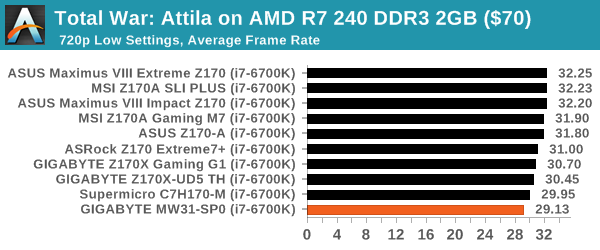
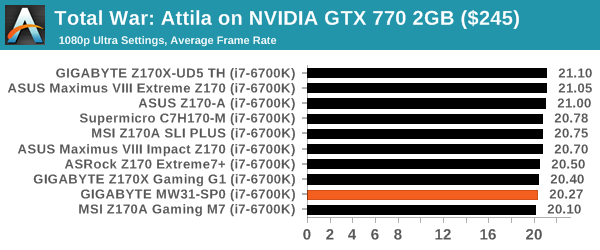
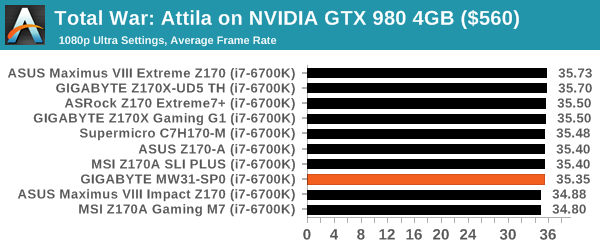
Grand Theft Auto V
The highly anticipated iteration of the Grand Theft Auto franchise finally hit the shelves on April 14th 2015, with both AMD and NVIDIA in tow to help optimize the title. GTA doesn’t provide graphical presets, but opens up the options to users and extends the boundaries by pushing even the hardest systems to the limit using Rockstar’s Advanced Game Engine. Whether the user is flying high in the mountains with long draw distances or dealing with assorted trash in the city, when cranked up to maximum it creates stunning visuals but hard work for both the CPU and the GPU.
For our test we have scripted a version of the in-game benchmark, relying only on the final part which combines a flight scene along with an in-city drive-by followed by a tanker explosion. For low-end systems we test at 720p on the lowest settings, whereas mid and high-end graphics play at 1080p with very high settings across the board. We record both the average frame rate and the percentage of frames under 60 FPS (16.6ms).

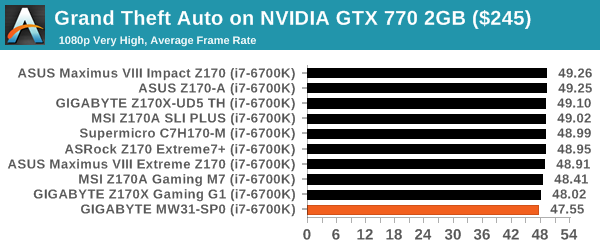
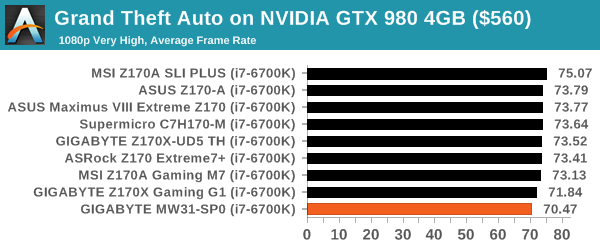
GRID: Autosport
No graphics tests are complete without some input from Codemasters and the EGO engine, which means for this round of testing we point towards GRID: Autosport, the next iteration in the GRID and racing genre. As with our previous racing testing, each update to the engine aims to add in effects, reflections, detail and realism, with Codemasters making ‘authenticity’ a main focal point for this version.
GRID’s benchmark mode is very flexible, and as a result we created a test race using a shortened version of the Red Bull Ring with twelve cars doing two laps. The car is focus starts last and is quite fast, but usually finishes second or third. For low-end graphics we test at 1080p medium settings, whereas mid and high-end graphics get the full 1080p maximum. Both the average and minimum frame rates are recorded.
Average Frame Rate / Minimum Frame Rates
Click through for full-sized images
Middle-Earth: Shadow of Mordor
The final title in our testing is another battle of system performance with the open world action-adventure title, Shadow of Mordor. Produced by Monolith using the LithTech Jupiter EX engine and numerous detail add-ons, SoM goes for detail and complexity to a large extent, despite having to be cut down from the original plans. The main story itself was written by the same writer as Red Dead Redemption, and it received Zero Punctuation’s Game of The Year in 2014.
For testing purposes, SoM gives a dynamic screen resolution setting, allowing us to render at high resolutions that are then scaled down to the monitor. As a result, we get several tests using the in-game benchmark. For low-end graphics we examine at 720p with low settings, whereas mid and high-end graphics get 1080p Ultra. The top graphics test is also redone at 3840x2160, also with Ultra settings.
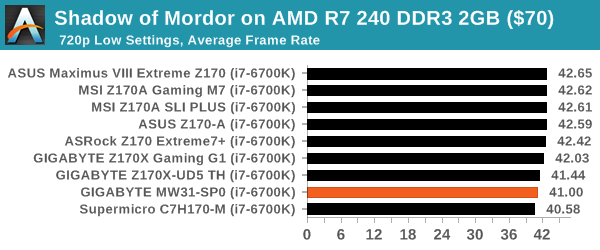
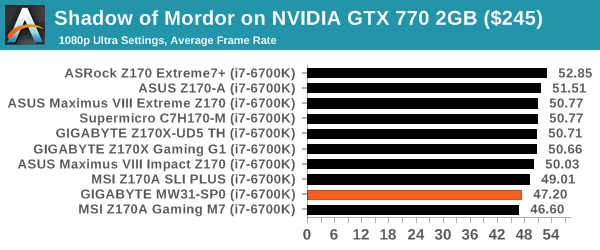
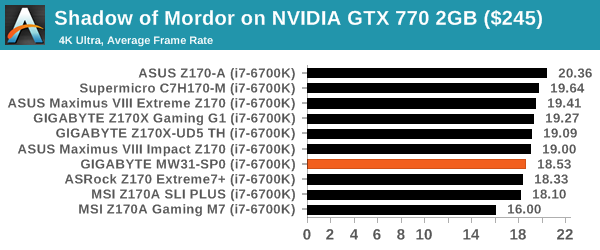
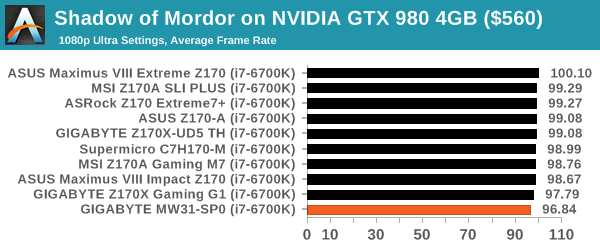
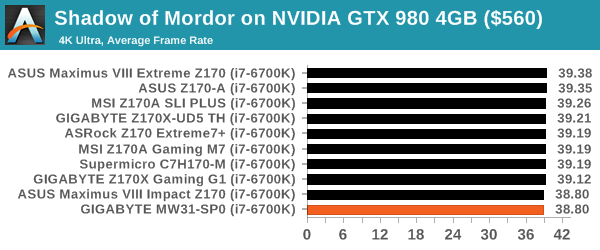







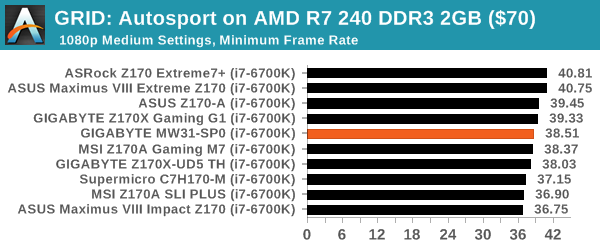
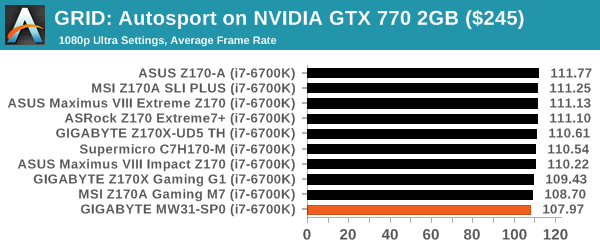
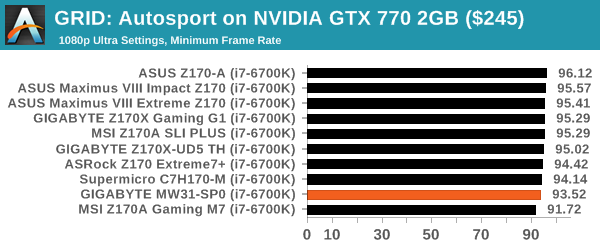
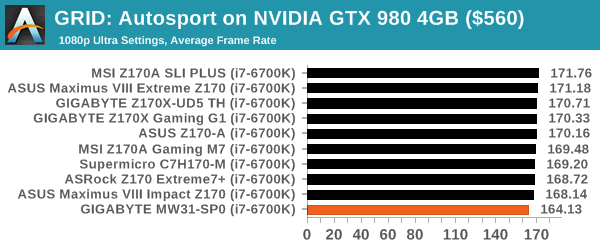
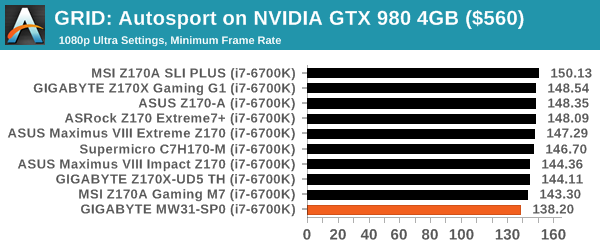









28 Comments
View All Comments
SFNR1 - Thursday, April 21, 2016 - link
Nice Review, but WHY always PNG for the product photos?aznronin - Thursday, April 21, 2016 - link
Probably because they include graphical text elements, even though its only a minor part of the image PNG will keep them looking sharper than jpeg. As long as they aren't using PNG 24bit it shouldn't be a huge hit on image size either.jasonelmore - Thursday, April 21, 2016 - link
text and transparent backgroundsRaistlinZ - Thursday, April 21, 2016 - link
What's wrong with PNG?SFNR1 - Friday, April 22, 2016 - link
The filesize? This is from his other article: http://images.anandtech.com/doci/10236/MSI%20Z170A... . 5 MB? Ok, transparency is a point, didn't see that.bernstein - Friday, April 22, 2016 - link
it's not a problem of png, it's a problem it the editor... the example png can easily be reduced to 512KB without any visual loss, it's just that most editors don't have these features built-in (reduction of colors, use of optipng+zopflipng)slyphnier - Friday, April 22, 2016 - link
is there any issue with PNG ?PNG is internet standard images, unofficial replacement to gif
it have proper transparancy that jpg/jpeg not have, basically its lossless format
and i dont think any image viewer having issue with it either ... so not sure why someone complain PNG images?
DanNeely - Friday, April 22, 2016 - link
PNG photos are normally huge compared to JPEGs. Their advantages are for text (paying size for lossless to make the text artifact free) or for images with large areas that are single color and thus compress really well (eg non gradient covered screenshots).DanNeely - Thursday, April 21, 2016 - link
Speaking of custom IO cards, very expensive machinery, and boards with legacy IO connectors; have boards with an ISA slot (80s/90s era expansion card) finally gone the way of the Dodo? At least as recently as the Core 2 era I know there was at least one vendor selling boards with a slot for one to people who needed to keep elderly hardware alive.DigitalFreak - Thursday, April 21, 2016 - link
DFI makes a Haswell motherboard with ISA slots.